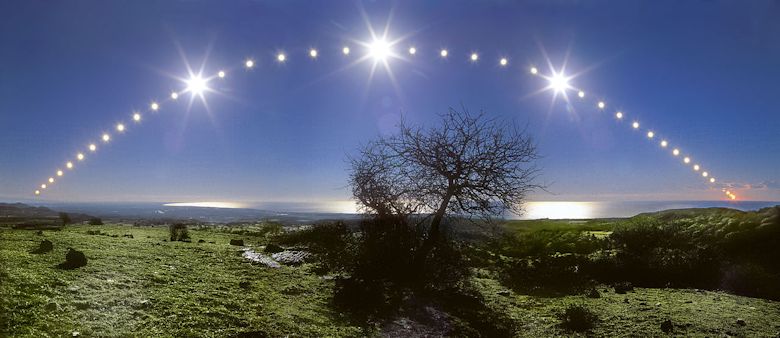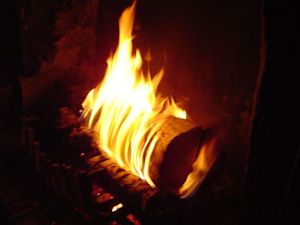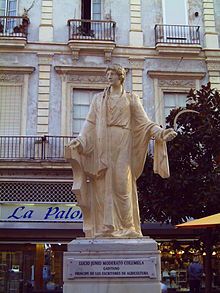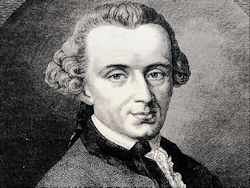
The solstice occurs today with the Sun reaching its southernmost declination in the Earth’s sky. Of course, the December solstice marks the beginning of winter in the northern hemisphere and summer in the south. When viewed from northern latitudes, the Sun will make its lowest arc through the sky along the southern horizon. So in the north, the solstice day has the shortest length of time between sunrise and sunset and fewest hours of daylight. This striking composite image follows the Sun’s path through the December solstice day of 2005 in a beautiful blue sky, looking down the Tyrrhenian Sea coast from Santa Severa toward Fiumicino, Italy. The view covers about 115 degrees in 43 separate, well-planned exposures from sunrise to sunset. Photo: Danilo Pivato.
Supporter Spotlight
 |
Our family celebrates winter solstice with an outdoor Solstice Fire, mostly as an excuse to spend an evening outside, keeping company while warmed by kindling and logs being turned to embers and ash.
Technically speaking, winter solstice, which arrives today, is an astronomical event marked by observable phenomena that many cultures and peoples throughout history have come to recognize as significant and worth celebrating. Winter solstice is a noteworthy date because on this day the sun at noon is at its lowest arc over the horizon and it is truly the shortest day of the year; slated to last nine hours, forty nine minutes, and twenty four seconds. The day before and day after winter solstice are each a full one-second longer; nine hours, forty nine minutes and twenty five seconds, respectively.
Early cultures in northern Europe recognized this period as a midpoint of winter, and a time to take stock of provisions set aside to carry their family or community to spring. Prior to present-day modern comforts and conveniences, winter was a dreaded season for many peoples, in northern regions especially because game animals, including waterfowl and herding mammals migrated to more bountiful lands to the south while calorie-bearing plants were dormant and often covered by ice and snow. Fishes and other aquatic quarry are also harder to find and capture during winter ice and cold, when daylight is brief and nights are long.
However, with the passage of winter solstice, successive days grow progressively longer, albeit in brief increments, but enough for celebration. Historians tell us early winter solstice revelries in northern cold climes may have involved fire as symbolic representation of light returning to the world; a rebirth of sorts.
I get it. Fire provided people with tangible, comforting heat and it offered a spirit-lifting representation of hope that, following winter solstice, coming days would subtly though not imperceptibly grow longer; a world once shrouded by prolonged life-sapping night would be transformed and made more cheery by lengthening days augmented by sunshine warming the landscape; something to look forward to– a hope that carried people through the difficult and tiresome periods when cold and fearsome weather conspired with scarce food or shelter.
Supporter Spotlight
 A statue of Columella, holding a sickle and an ox-yoke, in the Plaza de las Flores, Cádiz. |
It is counter-intuitive therefore, for me to think of winter solstice as the start of winter because, logically, with ever lengthening days and more light, it just seems logical that winter solstice signifies the start of spring.
When I ponder the relevance of winter solstice it is easy for me to slip into thoughts regarding phenology; the timing of things happening in nature including ripening of fruits, and migrations of wildlife.
Roughly defined, phenology is the study of when things appear, and it is gaining renewed popularity. I say “renewed” because people have studied the timing of things ever since we started paying attention to the world around us; committing to memory those things and events we observed and experienced, thereby framing and building our view and understanding of nature’s happenings.
As a natural science pursuit, phenology was popularized in Europe during the 18th and 19th centuries. But before it became a pastime, recognizing seasonal changes was a necessity for human survival. In order to endure the rigors of fluctuating food sources, including game animals and plant fruits that come and go with changing seasons, it was necessary to plan for inevitable food scarcities as a strategy to avoid famine; planning for seasonal food scarcities that were anticipated from one year to the next because we paid attention to worldly changes around us.
I think the development of phenology as a community pursuit was a revolutionary and transformative episode in human social development, with traditional winter solstice fires as evidence that early peoples not only recognized changes in the world around them, they anticipated future, hopeful changes to come. I wonder then, if it was hope that drove our ancestors’ actions leading up to winter , including storing foodstuffs, securing shelter, and portioning resources sufficiently so as to avoid privation in winter ; living sufficiently by conserving (wisely using) resources.
And this brings me to a matter that has been nagging at my mind; present widespread marketing of the word sustainable, as in: Sustainable Living, Building, Growing, and Consuming. Sustainability as a buzz-term is especially vogue in the environmental community, and not surprisingly, the advertising industry. We use the word as though it has measurable relevance, and maybe it does, though I have yet to find a simple mathematical formula to prove a sustainable behavior. Actually, the second law of thermodynamics pretty much discounts the possibility of anything being sustainable in the partially-closed system that is Earth; partially-closed because we get energy from the sun. But I digress.
 Immanuel Kant: What can I know? |
 Henry Thoreau: “It is better to cultivate a little land well than a great deal ill.” |
While recently exploring the distinction between sustainable and sufficient, I came across the writings of the 18th century German philosopher Immanuel Kant, to whom the study of reason suggested three questions in particular: “What can I know? What ought I to do? What may I hope?” These are dense questions but they offer helpful guidance.
So I ask myself: <em”>What can I know? As much as experience can provide. What ought I to do? It would be silly if I did something that limited the future. What may I hope? For the world, because the world provides me all I need.
In one form or other these are three questions social communities have asked for millennia; and I evoke the winter solstice fire as proof, assuming historians’ claims are correct in asserting solstice fires represent return of light and hope, and that better conditions are on the way. Yes, Kant was thinking theologically, and I only raise his questions because they can be relevant tools to justify actions, including those related to resource consumption.
Getting back to the issue of sustainable and sufficient; early peoples planning for winter knew that they must portion resources sufficiently. They may have used rudimentary mathematical models to figure out how, but regardless, life comforts in the olden days were measured by what is sufficient; “What ought I to do?” Surely, in order to be sustained for any duration on what resources are available, the answer must be, eat and use what you need, that there may be some for later.
There is little point in pondering whether building or consuming is sustainable because without some way to measure an action’s sustainability, it is not a relevant tool for resource metering. Again, in a closed system like ours, thermodynamics disposes the idea that limitless resource consumption is sustainable. I make no apology for irrefutable laws that govern our world.
Counsel for sufficiency is not new. While reading through the journal of Henry Thoreau (1817-1862), looking for a nugget of his insight regarding winter solstice, I serendipitously stumbled on a fun piece of his work from Dec. 22, 1855 when he wrote, “In reading Columella I am frequently reminded not only by the general tone but even by the particular warnings & directions–of the agricultural journals & reports of farmers’ clubs– Often what is last & most insisted on among us, was most insisted on by the Romans. As when he [Columella] says it is better to cultivate a little land well than a great deal ill.”
 President Theodore Roosevelt: “The nation behaves well if it treats the natural resources as assets which it must turn over to the next generation increased; and not impaired in value.” |
In the same passage, Thoreau quoted Columella (AD 4-AD 70), an important writer on agriculture, who was invoking the thoughts of the Roman poet Virgil (70 BC-19 BC): “Therefore, as in all things, so in buying land moderation will be used; for only so much is to be obtained as is necessary, to make it appear that we have bought what we can use, not what we may be burdened with, and hinder others from enjoying.”
I find it amusing, at some level, that this is me quoting Thoreau, quoting Columella, who was quoting Virgil; all of us regarding important advice pertaining to sufficiency. The idea of living sufficiently is not new, nor has it been kept secret.
Sufficiency is a thing we can measure, in calories, weight, and dimension (all four of them; three of size, and one of time: spacetime). Sustainable on the other hand, implies a future condition, which we can guess at, but cannot measure or predict with meaningful accuracy.
With our modern economic systems built on resource consumption, our challenge is not marketing the idea of sustainability; a nebulous word with no real metric for measurement. The challenge we face is marketing the value of sufficiency, as in “your possessions are sufficient.” Sufficiency is not a glass half empty; it is a pitcher half full.
My point in this: Winter solstice is a fitting time to take stock of our resources, but we should have long ago been taking stock of how we will manage them for the benefit of future generations, as President Theodore Roosevelt meant when he said: “The nation behaves well if it treats the natural resources as assets which it must turn over to the next generation increased; and not impaired in value.”
These thoughts shared, I will burn a sufficiently warm winter solstice fire, and in so doing, provide enough light-of-happiness to hope for.
Peace.







